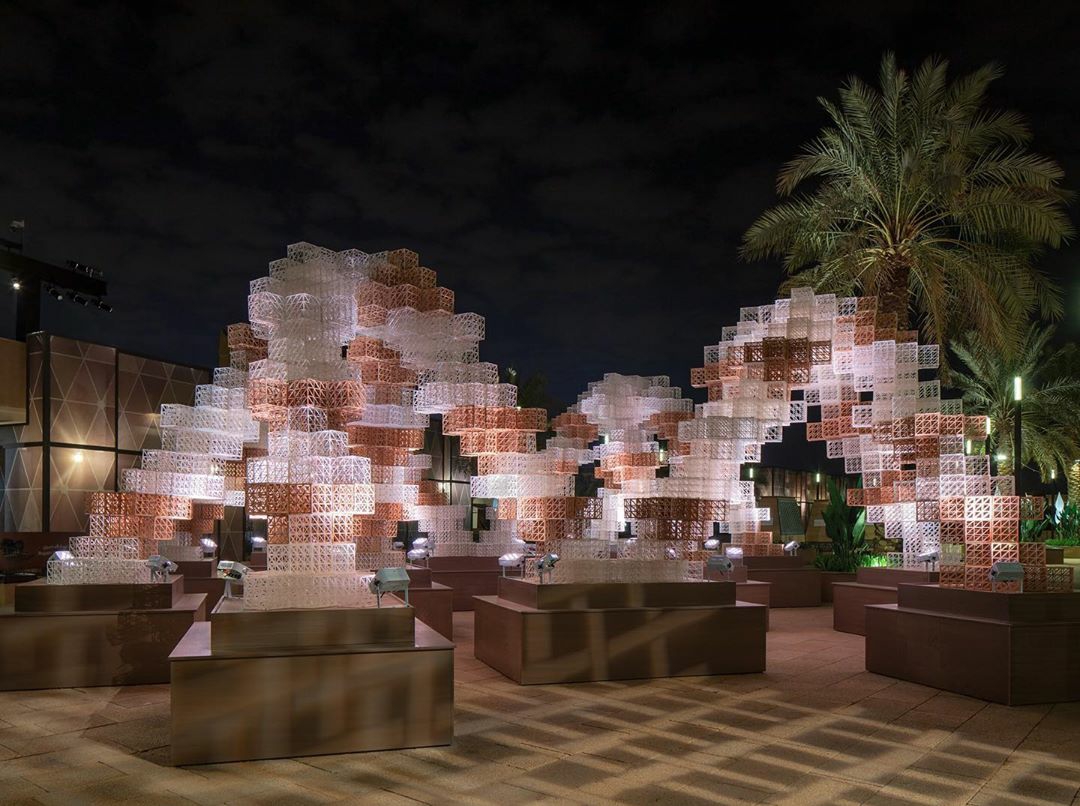Architectural design studios Precht and Mamou-Mani Architects have constructed a pair of installations in Saudi Arabia using 3D printing.
The first installation, named Sandwaves, uses a sand 3D printing method and features lattice structures woven in a ribbon-like formation. The second piece comprises a set of stacked cubes, named Pixel Gate, 3D printed using a standard extrusion-based method.
Both installations are located in Diriyah, and are intended for use as street furniture. They were specifically designed and built for the Diriyah Season, a set of international sports and entertainment events held at Al Bujairi Heritage Park, Riyadh. Precht and Mamou-Mani partnered on the installations for their client Designlab Experience, a specialist in urban art installations. Both installations were also built in collaboration with UK-engineering firm Format.
“We believe that true innovation builds upon the achievements of the past. Innovation looks at history, learns from it and reinvents it for our future demands,” comments Chris Precht, co-founder of Precht.
“We believe that responsibility starts locally and uses regional resources to create visionary projects. The Sandwaves are an example of responsible innovation that can have a positive impact on the future of our built environment.”

Who are Precht and Mamou-Mani?
Headquartered in Austria, Precht is a design studio focusing on architecture, interiors, landscapes & products. The company consists of a group of creatives, led by designers Fei and Chris Precht. The company was launched by the Precht’s in 2019.
Mamou-Mani Architects on the other hand is based in London. Founded by Arthur Mamou-Mani, the studio specifically specializes in digitally designed and fabricated architecture, with a focus on ‘Industry 4.0’. As such, Mamou-Mani is primarily focused on leveraging computational design and fabrication tools, like 3D printing, to generate its architectural designs.
Mamou-Mani is also the developer of Silkworm, an add-on for 3D modeling software Rhino3D and its Grasshopper plug-in. Silkworm allows users to translate the Rhino geometry into GCode for 3D printing, providing increased control over movement and extrusion. Additionally, Mamou-Mani is also the owner of fabpub, a digital fabrication workshop in East London that allows designers to book 3D printing and laser cutting machines for creating their prototypes and designs.
Previously, Mamou-Mani designed a temple for the Burning Man event featuring a 3D printed mandala. 3D Printing Industry spoke with Arthur Mamou-Mani about the use of 3D software, 3D printing and robotics in the design and realization of the Galaxia temple. Additionally, the design studio has also collaborated with COS, a London-based contemporary fashion brand, to create a 3D printed bioplastic installation, known as the Conifera, for Milan Design Week 2019.

The Sandwaves and Pixel Gate installations
Comprising 58 individual 3D printed components, the Sandwaves installation was 3D printed using a Furan Direct Binding method. Utilizing a 3D printer from binder specialist ExOne, this process uses a furan resin to bind sequentially-laid layers of sand. Sand was used to 3D print the structure as it is an abundant raw material in Saudi Arabia, helping to improve the sustainability of the project. Its continuous ribbon-like design was created to evoke a series of narrow alleys and wide spaces. As sand is not a very strong material, the team ended up using thick members for the structure, with each piece weighing around 160kg.
The perforated design, realised with the capabilities of 3D printing, also complies with the nature of the surrounding architecture, which features sun-breakers and palm trees. The Precht and Mamou-Mani designers also worked with structural engineers from Format to optimize the shape and thickness of each 3D printed piece using parametric design tools.

The Pixel Gate installation, on the other hand, was 3D printed in a compostable PLA, the same material used to 3D print the Conifera in 2019. Its name refers to the pixelated appearance generated from the use of multiple of cubes to form the structure. The member sizes and directions for each ‘pixel’ were optimized according to material distributions, as well as support systems and foundations with help from Format.
Subscribe to the 3D Printing Industry newsletter for the latest news in additive manufacturing. You can also stay connected by following us on Twitter and liking us on Facebook.
Looking for a career in additive manufacturing? Visit 3D Printing Jobs for a selection of roles in the industry.
Featured image shows the Sandwaves structure. Photo via Precht/Mamou-Mani/Roberto Conte.


